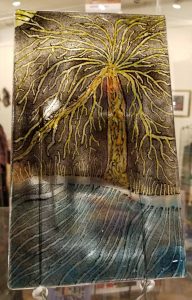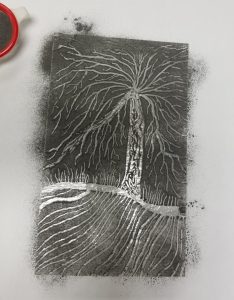Glass artist Cheryl Gutmaker has run out of peacock green-colored glass. Since this color was one of the most popular in last year’s designs, it is frustrating that she can’t get more. Two companies that supplied the glass closed two years ago. A third company has no projected date for when they will manufacture this color again.
But Cheryl takes the challenge in stride. She has shifted gears many times in her life when she has hit speed bumps. She recreated herself after losing her job as a music teacher due to budget cuts. She beat cancer. And then she began a career in glass when others might have thought of slowing down.
Cheryl has just returned from a four-day workshop at The Bullseye Resource Center in Mamareneck, NY. Her voice crackles with excitement about what she learned at this renowned glass center. “We played with different textures of glass in the kiln and experimented with firing different sizes of glass together,” she explains. “We explored what effect there would be if you fired the same piece at different degrees. How is it going to affect the material? How is it going to look different? How will the color change?” One of the thrilling parts of the workshop for Cheryl was playing with frit powder, or tiny bits of glass, that allowed her new possibilities in her artwork. “I have always wanted to make a weeping willow tree and never could get the effect until taking this glass course,” she says. (See photos )
)
She’s come a long way from her artistic beginnings. She began her career as a glass artist creating beads for jewelry. She forged them with a torch, glass rods and an annealing kiln. After accumulating baskets of beads, she looked for a new way to use her kiln. “I started making soap dishes because I could fit three in the kiln.” They were a hit. Now Cheryl owns seven kilns and uses the small annealing kiln to make handles for her large serving platters and bowls.
Recently, Cheryl has been experimenting with more complex techniques. Painting with glass – called frit paintings – intrigues her the most. Creating a landscape takes enormous planning and a wealth of knowledge about fusing glass. “If I put a bird on a branch, I have to figure out if I should fire the bird first.” Cheryl explains that glass will react differently at different temperatures. The juxtaposition of pieces of glass also impacts the eventual artwork because of the presence of differing amounts of copper, sulphur and lead. “I want a nice amber in the background but amber is very reactive so there has to be clear glass between the amber glass and other pieces,” she says. There are also a finite number of times you can fire glass. “Some glass can only be fired three times before it starts to break down, while others can be fired 25 times.”
Her knowledge is dizzying but she is constantly learning. Sometimes, the best lessons come from mistakes. “When I put on little bits [of glass], I use Superglue to tack them into place. Sometimes the glue burns off before I want it to and the glass slides a bit. I was doing eyes for crabs and they slid so that the crab came out with googly eyes.” Her customers loved them so much that she changed her design.
But for now, Cheryl is trying not to make any mistakes. She is busy creating inventory for the prestigious Paradise City Festival in Massachusetts in May, facing many happy hours fusing glass. If you own one of Cheryl’s creations with peacock green in it, consider yourself especially lucky. It may be a while before a matching piece will be available.
